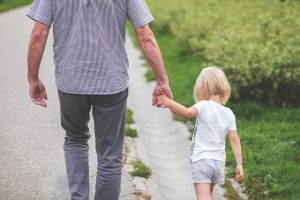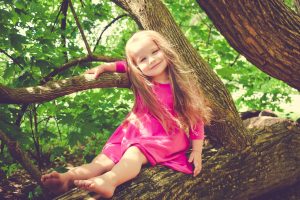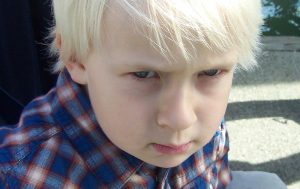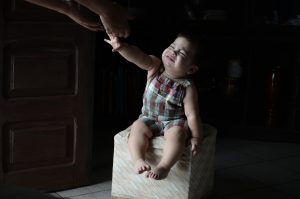4.1 Attachment

True story
The Senior Guidance Officer knocked on the door of the Intervention Centre. With her was a small boy, Max, who was younger than the stipulated age range of 10 – 15 years. This was a ‘regional’ case so Max’s age was irrelevant. He was eight years old. The information offered at this point in time was “You do not need to know the details of what this little boy has suffered. Just start with helping him learn how to be at school and not to hit and punch people.”
Welcomed into the classroom, Max was guided by the Intervention Centre teacher and encouraged to choose any activity he wished. Hesitant, silent and avoiding eye contact at all costs, he gathered the big pillows from near the book display, dragged them to the large table in the front corner of the room beside the door, climbed under the large table and used the pillows to barricade himself in. And there he stayed until home time.
This day was the beginning of a four-year relationship. A relationship that saw heartache, tears and joy. A relationship that made a positive difference to the life of this small boy who had experienced complex trauma, the nature of which no child should ever have to endure.
Attachment
“A key adult can really make the difference” (Bomber, 2009, p. 58).
What is attachment? Human beings need connections. They need to feel safe and secure. We explore our worlds connected to and immersed in the experiences of others who are the important people in our lives. Donald Winnicott (1964) said “There is no such thing
as a baby; there is a baby and someone”. Babies are social little beings that need to live connected with the other people in their world. This need is one of instinct and it is instrumental in their survival. Whatever happens in their environment and the experiences that they have within it, becomes the content of their brain. If we think of the baby’s brain as a blank book, everything they experience is written into the pages and informs what happens next. The relationship with the parent or carer is the author of the book and literally determines the structure and the functioning of the baby’s brain. Over the years as the baby grows, the experiences they have fill the chapters of the brain and shape the person they will become both socially and mentally.
Feeling safe allows infants and children to explore with confidence, demonstrate flexibility and take risks knowing they are supported and cared for. The role of the parent or caregiver in meeting the needs of the infant and nurturing positive relational interactions, is critical to the development of secure attachment. The primary attachment figure is the adult to whom the infant turns in times of crisis when they need comfort, security and protection. But what if the attachment figure is the person who is hurtful, abusive and frightening? What if when a baby cries, they are not picked up, held tenderly and reassured that they are loved, and everything will be alright? What then? When a parent or carer comforts their crying baby with consistent and caring behaviour, their actions are the beginnings of teaching the baby how to self-regulate. If the caregiver is unable to consistently respond, secure attachment is difficult to form, and this has a detrimental effect upon social emotional development.

As we know, early childhood, especially the first three years, is the time when the brain absorbs information at a rapid rate. The contents of the brain are constantly making connections perpetuating learning and exploration that is switched on by the richness and predictability of the parent/carer relationship. The attachment the child feels is governed by their experience of being safe and having their needs met. It is within this relationship that the child makes sense of the world and their place in it (Perry, 2009). It is here that they build a sense of self-worth, trust in others, the capacity to manage emotions and solve problems. When the relationship is one of fear and abuse, the traumatised child will most commonly develop poor self-worth, thoughts of shame and being unlovable (Tobin, 2016).
Research has found that before children have developed what is called explicit memory that is memories of events that are factual, logical and language based, they remember what happens to them through implicit memory. Implicit memory is memory without words that is imprinted on the brain through the intense feelings experienced through for example sight, smell and sound. So, a baby, will from the earliest stage of development, remember and respond to the memory without having the words – they feel it (de Thierry, 2015). Attachments that are secure, wrap the child in a protective layer that provides a safe space where capacity can be built, and hopeful futures can flourish.
Attachment theory
John Bowlby (1958) is the founder of attachment theory. Attachment theory attempts to explain attachment and attachment behaviour. Attachment behaviour is the observable action that the person does to be able to be physically close to the attachment figure and remain there. Attachment behaviour is evident throughout our life, and to know there is a significant ‘attachment’ person who will help us in times of need provides us with protection. Attachment develops across the first three years of life (Breidenstine, Bailey, Zeanah, & Larrieu, 2011).
Ainsworth was a colleague of Bowlby’s and together they were the first to suggest that a baby or child did know what was happening and felt the effects of having born witness to the loss of a caregiver or a traumatic event. Bowlby conceptualised the notion of a ‘secure base’ and in 1978 together with her colleagues, Ainsworth investigated this notion of a secure base concluding that the mother is the base from which the infant explores the world. Further, Ainsworth (1979) categorised attachment into secure and insecure and further sub-categorising insecure attachment into resistant, avoidant and disorganised attachment. Together with Bell, the Strange Situation Procedure was developed in 1970.

The power of attachment [2 mins 48 sec]
Watch Dr. Edward Tronick’s seminal ‘still-face experiment,’ which is a powerful illustration of child attachment and the impact of abuse and neglect. A transcript and Closed Captions are also available within the video: https://www.youtube.com/watch?v=apzXGEbZht0
Research has categorised attachment into four types:
- Secure
- Insecure avoidant
- Insecure ambivalent
- Disorganised
Secure attachments are protective by nature and insecure attachments serve as risk factors. Children with secure attachment have an equal need for proximity and exploration. It is important to remember that attachment types can change over time and that an attachment type, is not a diagnosis. Following is a brief outline from the child’s perspective of each of the attachment types:
- Secure attachment – “I feel safe and loved. The adults in my world are nurturing, respond quickly and calmly when I am upset, fill my basic needs, they interact warmly and are joyful about me. I trust them.”
- Avoidant attachment– “I feel detached. The adults in my world are indifferent about me. They give me very little emotional support, so I rely on myself and ignore other people. I prefer to be on my own.”
- Ambivalent attachment– “I feel misunderstood. The adults in my world love me one minute and hate me the next. I throw a wobbly to get what I want. I am clingy, demanding and needy.”
- Disorganised attachment – “I feel frightened all the time. The adults in my world are scary and mean. I live in fear and I worry all the time.”
Secure attachment

The function of secure attachment is safety and protection. In the relationship of secure attachment, the vulnerable child has their emotional and physical needs met and develops a feeling of confidence and calm. The child learns to trust and has an expectation that a caring adult will respond in a loving and caring manner when meeting their needs. Secure attachment allows the child to learn through the demonstration by the caring adult, how to self-regulate their behaviour and therefore as they grow become more able at controlling emotions and impulses (de Thierry, 2015; Howard, 2013; Sorrels, 2015). The secure child has a view that embodies compassion and empathy for others as well as competency and belief that they are loved and valued.
How does the child feel? Happy, safe and supported. They are more cooperative and can adapt more easily to the academic and social demands of school.
Avoidant attachment

The child with avoidant attachment avoids building a relationship with the teacher and instead focusses on the task. Contact with people means uncertainty and therefore should be avoided. In infancy, the child’s mother has struggled to cope with her own distressful situations and anger and therefore has struggled to adequately meet the baby’s emotional needs. Lack of physical contact can lead to the child avoiding being close to others. In class this child often presents as withdrawn and distant.
How does the child feel? Unwanted, fearful, anxious and angry.
For the teacher, Geddes (2006) suggests that the best strategy is to “turn towards the task” (p. 83). The task provides a buffer between the student and the teacher and allows the teacher to be nearer the child without this proximity being overwhelming and triggering a negative response. The task therefore should be the focus of intervention.
Ambivalent attachment (or resistant attachment)

The child with ambivalent attachment demonstrates behaviours that goes in swings and roundabouts demonstrating opposite behaviours. For example, ambivalence is on the one hand they can be clingy and on the other wanting to be independent. They can also demonstrate aggressive and destructive behaviours (Geddes, 2006). Characteristic of this pattern of attachment is parenting with few boundaries and little control. Children with ambivalent attachment often have poor school attendance and their behaviour is controlled by the fear of not having their needs met.
How does the child feel? Vulnerable, separation anxiety, uncertain.
Disorganised attachment
Think back to the PBS triangle in the chapter one. Remember the three tiers of intervention – the green, yellow and red zones? While the behaviour of children with trauma associated with the various patterns of attachment can be considered ‘red zone’ behaviours requiring intensive individualised support, children with disorganised attachment are often easily identified as being in the red zone for their behaviour because their behaviour at school can be described as serious and disruptive. This behaviour is often visible for all to see and more often than not, it is the type of behaviour that results in suspension and exclusion.

Behaviours demonstrated can include aggression and meltdowns as well as complete ‘shut down’ and withdrawal type behaviours. This highly challenging behaviour may be reflective of a life of chaos and dysfunction. These students demonstrate factors associated with both ambivalent and avoidant attachment patterns (Sorrels, 2015). Possible happenings in this life may have been parents who experienced high levels of stress, substance abuse, mental illness making them unavailable to the child and scary. In some cases, the result for the child may have been to have witnessed or been a victim of abuse (physical, sexual, verbal) and neglect. These children demonstrate behaviour that is fueled by uncertainty and threat and therefore they are in a constant state of hypervigilance.
The child with disorganised attachment needs a safe-haven. A space that is safe, secure and predictable. They live with fear, anxiety and helplessness. Every day is about survival. Where in this picture of the traumatised child with disorganised attachment thinking is there any spare space for anything else? Enter the teacher with genuine care and consideration.
How does the child feel? Overwhelmed by fear, anxiety and helplessness. Unlovable and shameful.
![]()
Additional reading
Read Ziegler, D. (n.d). Understanding and treating attachment problems in children: What went wrong and how problems can be fixed. https://www.jaspermountain.org/understanding_treating_attachment_problem.pdf
Table 4.1 Types of attachment
| Attachment type | Characteristics | Home dynamic |
| Secure |
|
|
| Insecure avoidant |
|
|
| Insecure ambivalent |
|
|
| Disogranised |
|
|
Please note that Table 4.1 and the content within this chapter from Reaching and Teaching Children Exposed to Trauma by Barbara Sorrels, EdD, ISBN 9780876593509, is used with permission from Gryphon House, Inc., P. O. Box 10, Lewisville, NC 27023 (800) 638-
0928 www.gryphonhouse.com. Additional reproduction of this content is not permitted without prior permission from the copyright holder.
Reactive attachment disorder (RAD)
Another attachment pattern is reactive attachment disorder (RAD). Students with RAD typically have serious aggression problems often hurting others and shows little empathy or remorse. Safety seeking behaviours, anxiety and depression are characteristic of the condition coupled with an inability to be genuinely affectionate with others or to develop strong connections. Students with RAD feel the need to be in control and may demonstrate bossy, argumentative and defiant behaviours. Reactive attachment disorder is a mental health disorder diagnosed according to the criteria in the Diagnostic and Statistical Manual of Mental Disorders: DSM-5 (American Psychiatric Association [APA], 2013). Here it is characterised as a stress-related disorder which can only be caused by a lack of adequate care (social neglect) during childhood. Children with RAD demonstrate withdrawn, internalising type behaviours. RAD is only diagnosed in children and must be evident within the first five years of life.
RAD is a deficit in the child’s capacity to manage how they feel. As in the previous section when we looked at attachment types, if we think about RAD from the perspective of the child with it, characteristics could be described as follows:
- I do relationships and conflict poorly because my social, emotional and behavioural skills are ineffective in my interactions with others. It is the frequency, duration and intensity of my difficulties in many settings, that sets me apart.
- Why am I like this? My need for comfort, nurturing and connection as a baby/young child were not met. My world is or has been, one of neglect, fear and hurt. As a result, I cannot articulate my feelings and thoughts.
- I threaten, I throw tantrums, I am aggressive, I am demanding of your attention, I am manipulative, charming and angry. Behaving like this is the only way I can control relationships.
Remember that it is not our place to diagnose but to understand. Regardless of the type of attachment difficulty a child may have, they all need:
- Safety
- A caring adult who will be there
- Emotional support
- Understanding
- Behaviour support
- Routines and consistency
References
Ainsworth, M. D. S. (1979). Infant mother attachment. American Psychologist, 34, 932-937.
American Psychiatric Association. (2013). Diagnostic and statistical manual of mental disorders (5th ed.). Arlington: VA: American Psychiatric Publishing.
Bomber, L. M. (2009). Survival of the fittest! – teenagers finding their way through the labyrinth of transitions in schools. In A. Perry (Ed.), Teenagers and attachment. Helping adolescents engage with life and learning (pp. 31-62). Richmond, London: Worth Publishing.
Breidenstine, A. S., Bailey, L. O., Zeanah, C. H., & Larrieu, J. A. (2011). Attachment and trauma in early childhood: A review. Journal of Child & Adolescent Trauma, 4, 274-290.
de Thierry. B. (2015).Teaching the child on the trauma continuum. Claygate: Grosvenor Publishing
Geddes, H. (2006). Attachment in the classroom: the links between children’s early experience, emotional wellbeing and performance in school. London: Worth Publishing.
Howard, J. A. (2013). Distressed or deliberately defiant? Managing challenging behaviour due to trauma and disorganised attachment. Toowong, Australia: Australian Academic Press Group.
Perry, B. D. (2009). Examining child maltreatment through a neurodevelopmental lens: Clinical applications of the neurosequential model of therapeutics. Journal of Loss and Trauma, 14(4), 240-255.
Sorrels, B. (2015). Reaching and teaching children exposed to trauma. Lewisville, NC: Gryphon House, Inc.
Tobin, M. (2016). Childhood trauma : Developmental pathways and implications for the classroom. Australian Council for Educational Research (ACER). Retrieved from https://research.acer.edu.au/learning_processes/20
Winnicott, D. W. (1964). The child, the family and the outside world. London: Pelican

